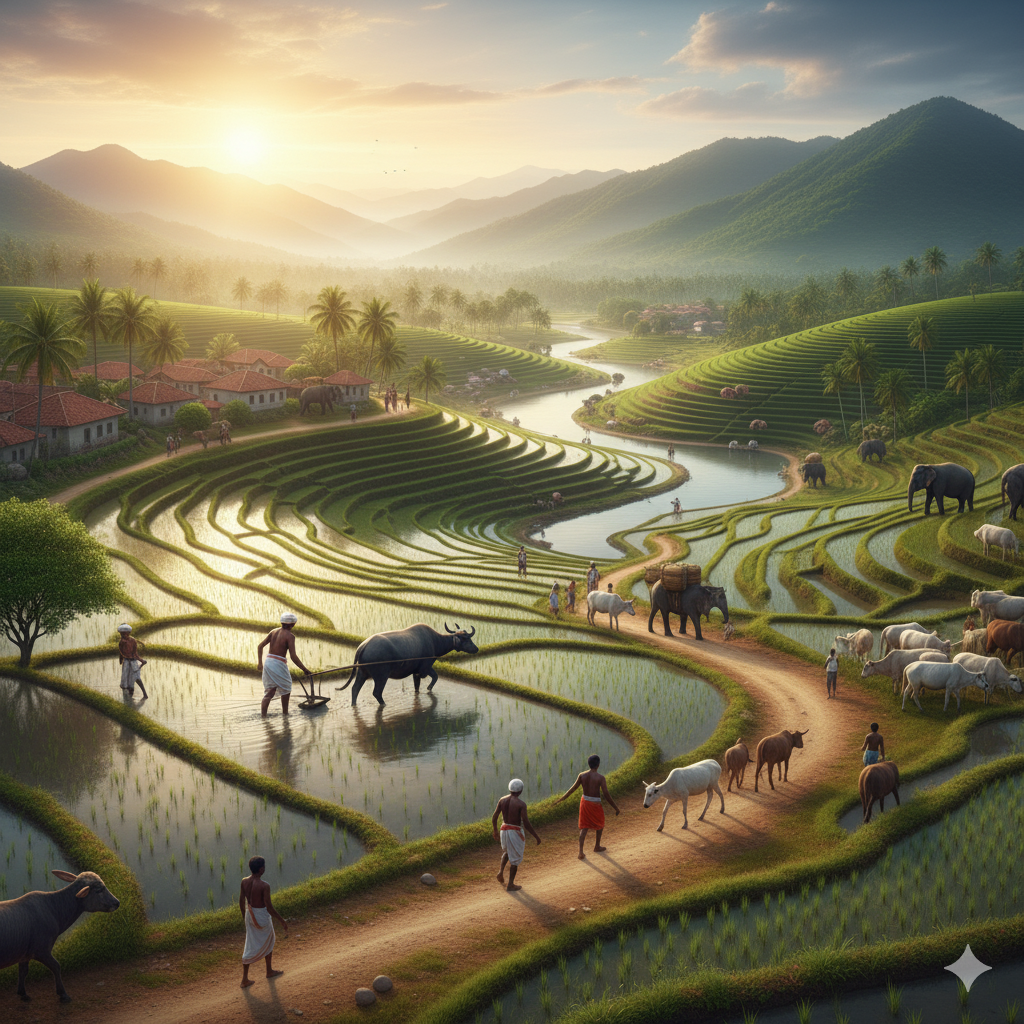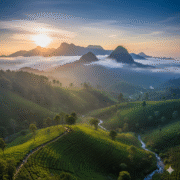
Cultivating Land and Caring for Animals: A Story of Sri Lanka’sAgricultural Heritage
- November 12, 2025
- eunoialankatours
- 4:54 pm
Sri Lanka’s relationship with the land is as old as memory
In the island’s villages it is easy to see how people live with the earth rather than simply on it. The way Sri Lankans have grown crops and tended animals has changed over millennia, yet threads of the past still weave through modern farms. This article takes you on a gentle journey from early domestication to today’s blended landscapes, drawing on history, science and the voices of the rural communities who keep these traditions alive.
From wild plants to the first farms
Around 10 000 years ago humans began to domesticate plants and animals. This transition – often called the Neolithic Revolution – created new agricultural ecosystems containing distinct populations of crops and livestock. Clearing land for cultivation altered natural habitats and brought dramatic social changes: population and technological innovations flourished, but denser settlements also allowed infectious diseases and nutritional stress to spread. In other words, farming was both a blessing and a challenge.
Sri Lanka does not have well-documented Neolithic farming sites, yet ancient chronicles such as the Mahavamsa suggest that early communities on the island learned to tame cattle and buffalo. Over time, three distinct cultivation methods developed: chena (shifting or slash-and-burn cultivation), irrigated wet-paddy fields and multi-story home gardens.
Chena: Sri Lanka’s oldest cultivation practice
Chena cultivation is widely regarded as the island’s oldest farming method – it has been practiced for around five millennia. Traditionally, villagers would prepare a single communal plot by clearing and burning a forest patch. Because chena relies on seasonal rains, seeds of millet, maize, mung bean and other dry-land crops were scattered just before the monsoon. The harvest provided staples such as finger millet and sesame while also supplying cotton for clothes and oil.
Life in a chena demanded cooperation and ingenuity. Each family received a share of the field and took turns guarding it from birds and elephants. Farmers built pambaya (scarecrows) and takeya – rough metal objects that clanged loudly – to deter animals. Watch huts (pela) dotted the field boundaries, and simple wooden fences (danduvata) kept out wandering cattle. After a few seasons the land was left fallow so that forest could regenerate and the soil could recover – an example of early ecological wisdom.
Wet-paddy cultivation and the artistry of water management
As populations grew, Sri Lankans began to master irrigated rice farming. Historical evidence suggests that irrigated paddy fields (often called goda vee) spread along the Malwathu, Mahaweli and Deduru rivers during the first millennium BCE. Farmers used buffalo-drawn ploughs to till and level muddy fields, worked decomposed plant debris into the soil and then flooded the plots before sowing. Once seedlings took root, fields were maintained by hand-weeding, and water levels were carefully managed until the grain matured.
These paddy landscapes were supported by ingenious irrigation tanks and canals. Villages arose below the bunds of large reservoirs, where seepage from the tanks created fertile ground for fruits and vegetables. Rice soon became the island’s primary staple; at times, Sri Lanka even exported surplus grain to India.
Home gardens: food forests of the hills
In the wetter central highlands and mid-country the ancient Kandyan Forest Home Gardens evolved. These gardens have a unique cultural identity, descending from the clans who settled around the last kingdom of Kandy. A typical garden resembles a small forest: towering jackfruit, mango and avocado trees shade spice crops such as nutmeg, pepper, cloves and cardamom. Beneath them grow a tapestry of vegetables, medicinal herbs and root crops. The multi-layered canopy conserves soil and water, provides food and income and offers habitat for birds and insects. Because of urbanisation and changing aspirations, however, this indigenous agro-forestry knowledge is at risk of being lost.
Animals in traditional livelihoods
While crop cultivation formed the backbone of rural life, domestic animals were essential companions. Ancient Sri Lankan kingdoms and monasteries kept cattle and water buffalo for milk, draught power and transport. Buffaloes trampled earth to strengthen reservoir bunds and pulled carts loaded with grain. Milk and its derivatives were prized; dairy foods such as curd, whey, ghee and butter enriched diets and were offered in ritual settings. Historical sources note that beef was consumed in earlier times but later banned during the Anuradhapura period as Hindu influence grew.
Herds were supervised by gopalaka (herdsmen). Branding identified ownership, grazing rights were regulated and severe punishments were imposed on cattle thieves. Grazing lands ranged from highland pastures beyond tank cascades to fallow chena plots. The interdependence of crops and livestock meant that manure fertilised fields and cattle provided traction for ploughs and threshing.
Fishing also featured in coastal and riverine communities. Inscriptions from the first century CE mention nets, baskets and hooks used to catch fish, though large-scale sea fishing was limited by the lack of preservation technology in ancient times.
Today’s agricultural landscape
Modern Sri Lanka still relies heavily on farming. Out of 65 610 km² of land, about 30% is used for agriculture, and the sector employs roughly a quarter of the population. Most agricultural land is devoted to crops, with less space for livestock. Rice remains the primary food crop; two main cultivation seasons feed the nation and support about a third of the workforce. Tea, grown in misty uplands, provides foreign exchange and supports about a million livelihoods. Rubber, coconut, fruits, vegetables and spices such as cinnamon and black pepper are significant exports.
Animal husbandry, by contrast, makes a modest contribution. The livestock sector accounts for roughly 1.2% of Sri Lanka’s GDP. According to the Department of Animal Production and Health, the country has about 1.3 million cattle, 0.3 million buffalo, 0.4 million goats, 13 million poultry and 80 000 pigs. Local dairy production supplies only part of national demand, so the island still imports powdered milk. Indigenous breeds have been largely replaced by cross-breeds adapted to different climatic zones, while buffaloes continue to provide power in rice fields and milk for curd.
Why these traditions matter
The diversity of Sri Lanka’s cultivation methods and animal husbandry reflects a deep respect for the island’s varied landscapes. Chena farmers understood fallow cycles long before the term “sustainable agriculture” existed. Paddy cultivators engineered sophisticated irrigation networks that still amaze engineers today. Home-gardeners created living pharmacies and supermarkets in their backyards, where one could gather jackfruit, spices and medicinal herbs on a single walk. Herdsmen integrated animals into cropping systems, closing nutrient loops and sharing labour through customs like the attham (mutual help) system.
These practices remind us that agriculture is not just an industry; it is a way of life entwined with culture and ecology. At Eunoia Lanka we believe that reviving and celebrating such knowledge can inspire more resilient food systems. By honouring time-tested farming wisdom and combining it with scientific innovation, Sri Lanka can nurture both people and the planet for generations to come.


